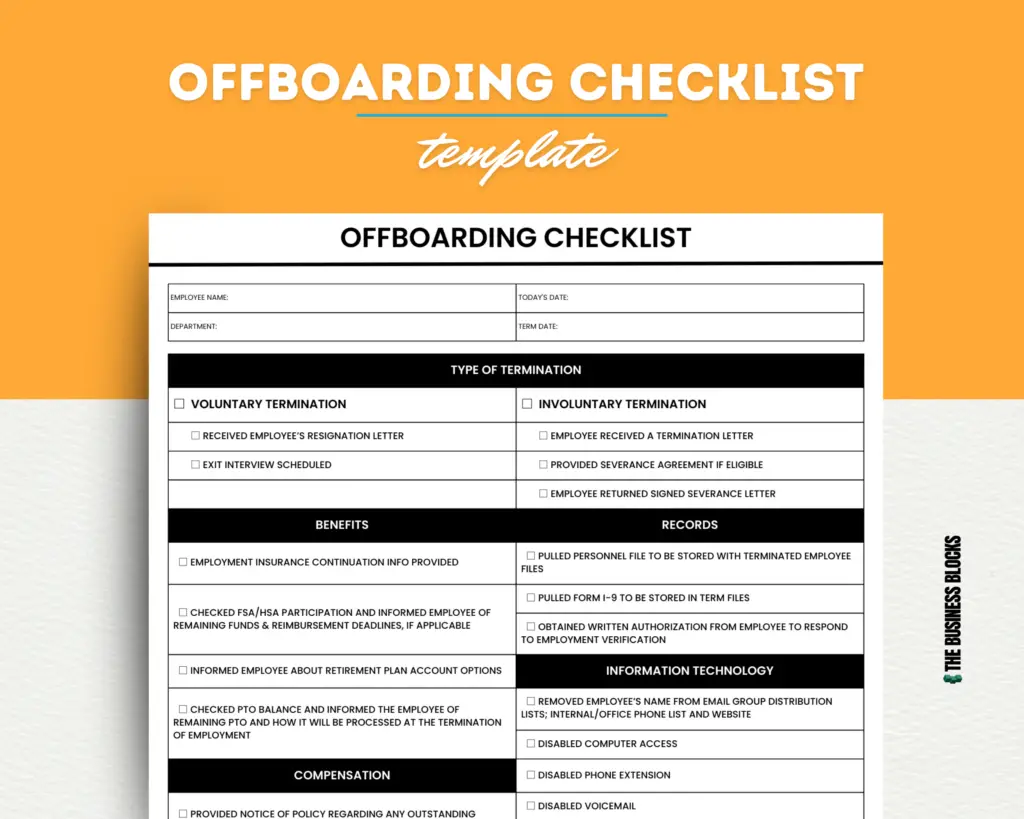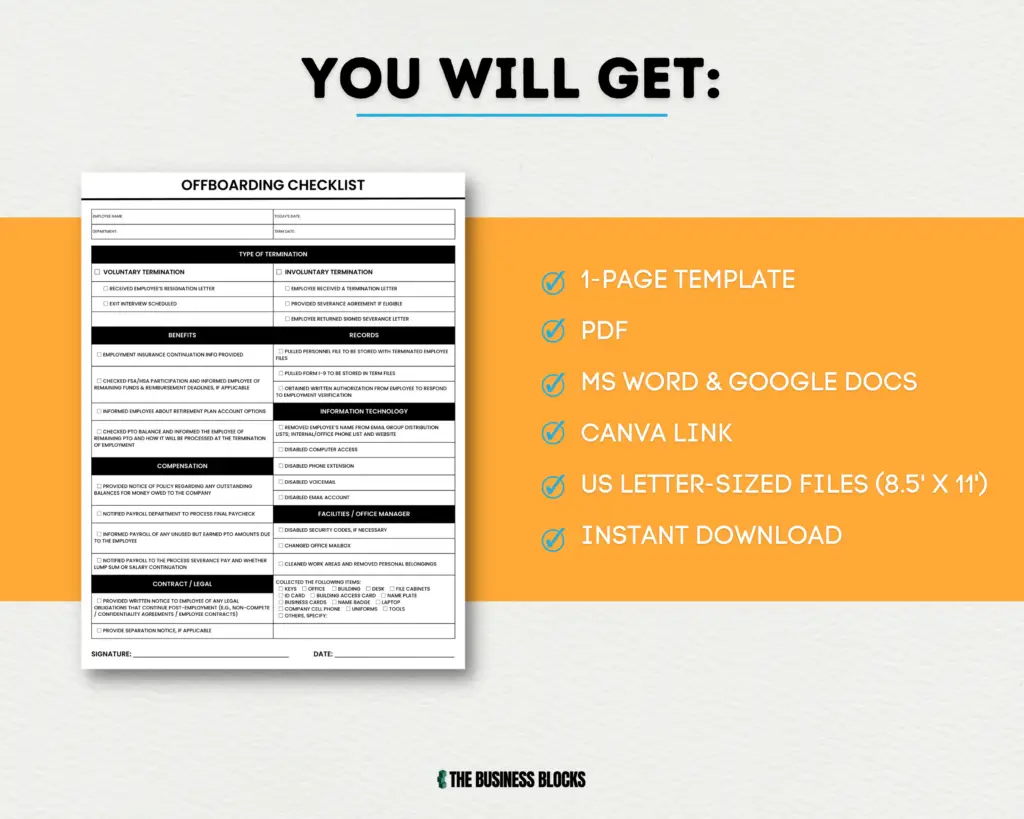What is an Employee Exit / Offboarding Checklist?
An offboarding checklist is a document that outlines the steps and procedures to be followed when an employee leaves an organization, either voluntarily or involuntarily. It is used to ensure that all necessary tasks are completed, and all company property is returned before the employee’s departure.
The checklist typically includes items such as collecting company property, returning keys, deactivating system access, transferring knowledge and tasks to other employees, conducting exit interviews, and ensuring that all necessary paperwork is completed.
The purpose of an offboarding checklist is to ensure that the employee’s departure is handled smoothly and professionally, without any disruption to the organization’s operations or security. By following a standardized offboarding process, the organization can protect its assets and sensitive information, while also maintaining a positive relationship with the departing employee.
Additionally, it can help ensure that the organization is compliant with any legal or regulatory requirements related to employee departures.
Common items that might be included on an Offboarding checklist:
- Collecting company property (such as laptops, phones, keys, and access cards)
- Deactivating system access (including email, network accounts, and software licenses)
- Transferring knowledge and tasks to other employees
- Ensuring that all necessary paperwork is completed (such as termination agreements and final paychecks)
- Conducting an exit interview to gather feedback and insights from the departing employee
- Cancelling any subscriptions or services associated with the departing employee
- Removing the employee from any internal or external communication channels (such as email distribution lists and social media accounts)
- Informing clients or customers of the employee’s departure and introducing a new point of contact
- Retrieving any confidential or sensitive information from the departing employee
- Following any legal or regulatory requirements related to employee departures (such as providing notice or paying out accrued vacation time)
Looking for Coworker Introduction Form?
A comprehensive Employee Exit Checklist Template is essential for organizations to manage the process of employee departures effectively. The checklist outlines the steps and procedures to follow when an employee resigns, is terminated, or retires.
By having a well-designed exit checklist, organizations can ensure that all necessary tasks, such as returning company property, offboarding from systems and networks, and conducting exit interviews, are completed efficiently and in compliance with legal requirements.
Moreover, a thorough exit process can help organizations protect their intellectual property and proprietary information, maintain positive relationships with departing employees, and preserve their reputation as an employer of choice.
This template is a terrific tool for any business because it’s not only simple to use but also polished.
You may quickly modify the template to match your unique demands and specifications because it is fully editable in Canva, Google Docs or Microsoft Word.


WHAT’S INCLUDED?
- Your Live Canva Document for Editing in 2 sizes US Letter (8.5″x11″) and A4 Size (8.27″ x 11.69″)
- Two Editable Google Doc Templates (US Letter and A4 Size), convertible to:
- Two Editable Microsoft Word Templates (US Letter and A4 Size), convertible to:
- Two Printable Adobe PDF Templates (US Letter and A4 Size)
REQUIREMENTS
- Google Account (for Google Docs templates)
- Microsoft Word (2007 or greater) for Windows or MacOS
- Canva Account (for Canva templates)
- Adobe Acrobat Reader
OTHER INFORMATION
To alter or modify these templates, some familiarity with Canva, Google Docs, or Microsoft Word is required.
No printed materials or physical products will be provided to you; this is a digital product.
The Business Blocks owns the rights of its designs. You may use the template as often as you like, but you may not share it with anybody outside of your business. Please get in touch if you need assistance with repairing or amending.
There are no returns because of the nature of the product, but we’d be happy to work with you to resolve any problems.

All-in-One HR Templates Bundle
With over 50 templates covering various aspects of HR, including recruitment, performance evaluation, employee benefits, and more, this All-in-One HR templates bundle provides everything needed to streamline HR operations and maintain compliance.
5 Reasons Why an Offboarding Checklist is Important for Your Business:
- Protects Company Assets: An offboarding checklist helps protect your company’s assets by ensuring that all company property, including physical and digital assets, are returned before the employee’s departure.
- Ensures Compliance: An offboarding checklist helps ensure that your business is in compliance with legal and regulatory requirements related to employee departures. This includes requirements related to final paychecks, accrued vacation time, and providing notice.
- Maintains Security: An offboarding checklist helps maintain security by deactivating system access, collecting keys and access cards, and ensuring that confidential or sensitive information is retrieved from the departing employee.
- Improves Employee Retention: An offboarding checklist can improve employee retention by providing a positive offboarding experience for departing employees. This can help maintain positive relationships with former employees and improve your reputation as an employer.
- Reduces Risk of Litigation: An offboarding checklist reduces the risk of litigation by ensuring that all necessary paperwork is completed and that legal and regulatory requirements are met. This can help protect your business from legal action related to employee departures.
Overall, an offboarding checklist is an essential tool for businesses looking to protect their assets, ensure compliance, maintain security, improve employee retention, and reduce the risk of litigation. By following a standardized offboarding process, businesses can ensure a smooth and professional departure for departing employees while minimizing disruption to business operations.
Wrap Up
In conclusion, an offboarding checklist is an important document for businesses of all sizes. By using an offboarding checklist, businesses can ensure that all necessary tasks are completed before an employee’s departure, protecting the company’s assets and maintaining security.
Additionally, an offboarding checklist helps ensure that the business is in compliance with legal and regulatory requirements, reducing the risk of litigation. A well-planned and executed offboarding process can also improve employee retention by providing a positive experience for departing employees.
Overall, an offboarding checklist is an essential tool for businesses looking to maintain a positive and professional relationship with departing employees while minimizing the risk of disruption to business operations.
